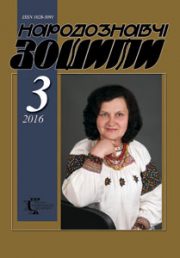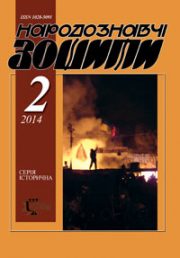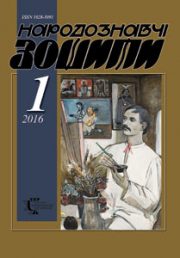The Ethnology Notebooks. 2021. № 5 (161), 1184—1193
UDK 787.1(477.52)”19″
DOI https://doi.org/10.15407/nz2021.05.1184
FOLK VIOLIN MUSIC PERFORMANCE IN NEDRYHAYLIV REGION (IN THE MIDDLE — SECOND HALF OF XX-th CENTURY)
HAVRYLENKO Viktoriya
- ORCID ID: https://orcid.org/0000-0002-5892-3129
- PhD student of Sumy State University,
- Head of the Department of Intangible Cultural Heritage
- Sumy Regional Scientific and Methodological Center of Culture and Arts
- 49, Petropavlivska St., 40000, Sumy, Ukraine,
- Contacts: e-mail: viktoriavangogh@gmail.com
Abstract. The purpose of the article. Local centers of folk violin music in the Sumy region have not been studied and covered in scientific publications yet. The purpose of the article is the outlining of the features of traditional violin music in Nedryhayliv and the surrounding area in the middle — second half of the twentieth century. Methodology. The research area includes the territory of Nedryhaylivshchyna (until 2021 it was a separate administrative district, now it`s a part of the Romensky district of the Sumy region). The methodology of the research is based on the method of field research (the data for the research were collected by interviewing violinists and other musicians, as well as old-timers of the villages of Nedryhayliv, Vilshana, Sakunykha, Zasullya, and Biloyarske). Methods of analysis and generalization were applied at the stage of processing expedition materials. Scientific novelty. Results of expeditions to the local center of violin tradition in the Sumy region have been introduced into scientific circulation.
Conclusions. In the middle — second half of the twentieth century in the Nedryhayliv region the violin was used both in the traditional trinity combination (two violins and a tambourine) and in combination with other instruments such as tambourine («bubon»), flute («sopilka»), harmonica («harmoshka»), balalaika which existed simultaneously in the research area. It was found that in the middle of the twentieth century, violin musicians took part in the holidays of the family-ritual cycle (baptism, wedding) and in special local forms of youth leisure («gryshche», «vesnyanka»). The specifics of local violin performance involve the use of typical techniques of the game. The traditional repertoire of violinists consisted mainly of Ukrainian dances and a small number of adopted dances. The way of mastering violin tradition by younger violinists was to master the game on their own by concentrating on frequent listening to the game of older violinists.
Keywords: violin music performance, wedding, «gryshche», «vesnyanka», musicians, violinist, Nedryhayliv.
Received 9.08.2021
REFERENCES
- Pirko, O., & Hurzhii, O. (1991). Description of the Kharkiv governorate of the end of the XVIII century. Kyiv: Naukova dumka [in Ukrainian].
- Arandarenko, N. (1849). Notes about the Poltava province, complied in 1846 (Part II). Lviv [in Russian].
- Sumtsov, M. (1918). Residents of the Slobozhanshchyna. Kharkiv: Soyuz [in Ukrainian].
- (1858). Life of a Ukrainian peasant (mainly in the Poltava province). Ethnographic digest (Issue 3, pp. 19—46). St. Petersburg [in Russian].
- Hrinchenko, B. (1895). Ethnographic materials collected in Chernigov province and neighboring provinces (Issue 1). Chernihiv [in Ukrainian].







